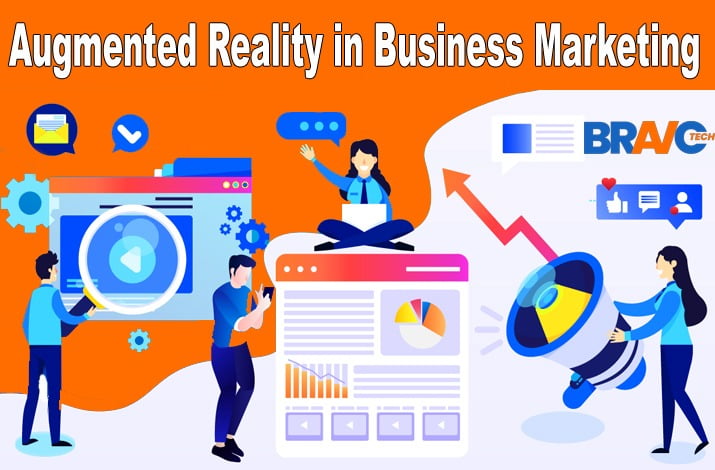What is Augmented Reality and its Role in Business Marketing

Augmented Reality (AR) has surfaced as a pioneering innovation that fuses the virtual and tangible domains, enriching the tapestry of user experiences. Overlaying digital data, encompassing images, videos, and three-dimensional models, onto the authentic surroundings engenders a captivating and interactive rendezvous. AR has forged its status as a potent implement within business marketing, galvanizing customer engagement, fostering brand cognizance, and propelling sales dynamics. In this discussion, we will examine how Augmented Reality is changing the way businesses market their products.
Augmented Reality is a technology that blends digital content with the real world, creating a seamless experience for users. Unlike Virtual Reality, which completely simulates an environment, AR enhances real-world experiences by adding virtual objects or information in real time.
In the swiftly evolving digital era, businesses incessantly seek inventive approaches to captivate their audience and distinguish themselves from competitors. Augmented Reality offers a distinctive solution by bridging the divide between the physical and digital realms, enabling brands to fabricate beautiful encounters that resonate with consumers.
How Augmented Reality Works?
Augmented Reality harnesses cutting-edge computer vision, sensing, and display technologies to overlay digital content onto the user’s real surroundings. It commonly consists of three essential elements:
- A camera or sensor that captures the real-world environment.
- A processor that analyzes and comprehends the gathered data.
- A display that showcases the augmented content to the user.
The Evolution of Augmented Reality?
Augmented Reality has undergone a remarkable evolution since its inception. Initially, it found primary usage in gaming and entertainment applications. Nevertheless, its potential rapidly spread across diverse industries, including business marketing. Presently, AR is applied in sectors such as retail, e-commerce, education, healthcare, and tourism, fundamentally transforming how businesses interact with their customers.
Read Also: Virtual Reality for Manufacturing: Use Cases and Benefits
Advantages of Augmented Reality in Business Marketing
AR has various advantages for businesses, regardless of their size and structure. Some of the main benefits are discussed here in detail.
Amplified Customer Engagement
AR delivers an extraordinarily engaging and interactive experience that captivates customers and forges enduring connections with brands. By enabling users to visualize products within their environment, businesses can elevate customer engagement and fabricate unforgettable experiences.
Enhanced Product Visualization
One of the considerable advantages of AR in business marketing is its capacity to exhibit products realistically. Customers can employ AR applications to try on clothing virtually, place furniture in their homes, or preview the appearance of makeup products on their faces. This enhances the decision-making process and reduces the necessity for physical prototypes or samples.
Personalized Shopping Experiences
AR empowers businesses to personalize shopping experiences by tailoring virtual content to individual customers. By scrutinizing customer data and preferences, brands can furnish targeted AR encounters that resonate with their audience, leading to heightened conversion rates and customer satisfaction.
Interactive Advertising
Augmented Reality bestows a novel dimension to advertising by enabling interactive and immersive campaigns. Brands can create AR experiences that permit users to interact with virtual objects, engage in games, or unlock exclusive content. This not only captivates attention but also aids in cultivating brand loyalty.
Amplified Brand Awareness
By harnessing AR technology, businesses can generate a buzz around their brand and engender viral marketing campaigns. AR experiences that are distinct, entertaining, and shareable possess the potential to reach a broader audience and organically amplify brand awareness.
Successful Examples of Augmented Reality in Marketing
IKEA Place App
The IKEA Place app empowers users to place furniture virtually in their homes to assess its fit and appearance before purchasing. This AR application has revolutionized the furniture shopping experience, augmenting customer confidence and diminishing returns.
Pokémon Go
Pokémon Go took the world by storm upon its release in 2016. The game harnessed AR technology to manifest Pokémon characters in the real world, establishing an addictive and immersive gaming experience that engaged millions of players globally.
Sephora’s Virtual Artist
Sephora’s Virtual Artist app allows users to try on various makeup products virtually. Users can experiment with different lipstick shades, eyeshadow, and other cosmetics by scanning their faces, enabling informed purchasing decisions.
Implementing Augmented Reality in Business Marketing


Organizations need to adopt a strategic approach to harness the potential of Augmented Reality in business marketing effectively. Here are the key steps involved in implementing AR:
Defining Marketing Objectives
Businesses should meticulously outline their marketing objectives and ascertain how AR can contribute to their achievement. Whether the aim is to augment sales, enhance brand awareness, or boost customer engagement, having a clear vision is paramount.
Identifying Target Audience
Gaining insight into the target audience is pivotal for devising compelling AR experiences. Businesses can fabricate AR content that resonates with the intended audience by scrutinizing customer demographics, behaviors, and preferences.
Choosing the Right AR Technology
An array of AR technologies is available, encompassing marker-based AR, markerless AR, and location-based AR. The selection of the appropriate technology hinges upon the marketing objectives, target audience, and budgetary considerations of the business.
Designing Engaging AR Experiences
The triumph of AR marketing campaigns relies on crafting captivating and user-friendly experiences. Brands should emphasize the creation of intuitive interfaces, seamless interactions, and high-quality visual content to deliver an immersive encounter.
Measuring and Analyzing Results
To evaluate the effectiveness of AR marketing endeavors, businesses should establish key performance indicators (KPIs) and meticulously track pertinent metrics. Analyzing user engagement, conversion rates, and customer feedback facilitates the optimization of future AR campaigns.
Challenges and Limitations of Augmented Reality
While Augmented Reality offers exciting prospects for business marketing, it confronts several challenges and limitations that necessitate consideration:
Technical Limitations
AR technology is still in a phase of evolution, and certain technical constraints persist. These encompass hardware limitations, such as restricted processing power and battery life, as well as software challenges pertaining to tracking accuracy and environmental conditions.
User Adoption
Achieving widespread user adoption of AR applications is imperative for their success in business marketing. However, some users may need more support to embrace new technologies or may need access to compatible devices, limiting AR campaigns’ reach.
Privacy and Security Concerns
AR applications often necessitate access to user data, including location, camera, and personal information. Addressing privacy and security concerns is vital to engender user trust and ensure compliance with data protection regulations.
The Future of Augmented Reality in Business Marketing
The future of Augmented Reality in business marketing is promising. As technology advances, we can anticipate more sophisticated AR experiences seamlessly integrating into our daily lives. The fusion of AI and machine learning will facilitate the creation of more personalized and context-aware AR content, further heightening customer engagement and propelling sales.
Final Thoughts
Augmented Reality is revolutionizing business marketing, presenting innovative avenues for brands to engage with their audience and fabricate immersive encounters. By leveraging AR technology, businesses can elevate customer engagement, enhance product visualization, and personalize shopping experiences. Despite encountering certain challenges, the future of AR in business marketing appears bright, offering boundless possibilities for brands to stand out in a competitive marketplace.
FAQs
Q1. Can Augmented Reality be applied to any industry?
Augmented Reality finds applications in various industries, including retail, e-commerce, education, healthcare, tourism, and more.
Q2. Do users require specialized devices to experience AR?
While dedicated AR devices such as smart glasses exist, many AR experiences can be accessed using smartphones and tablets.
Q3. Are there any notable instances of successful AR marketing campaigns?
Indeed, numerous brands have successfully implemented AR in their marketing campaigns, such as IKEA, Pokémon Go, and Sephora.
Q4. How can businesses measure the efficacy of AR campaigns?
Businesses can gauge the effectiveness of AR campaigns by monitoring metrics such as user engagement, conversion rates, and customer feedback.
Q5. What are the future trends in AR for business marketing?
Future trends in AR for business marketing include:
- Increasingly personalized and context-aware experiences.
- Integration with AI and machine learning.
- Seamless integration into daily life.





